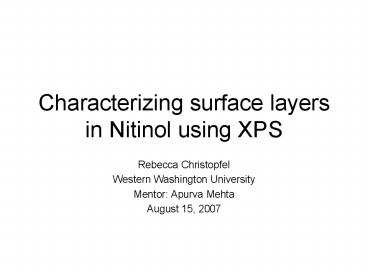Characterizing surface layers in Nitinol using XPS - PowerPoint PPT Presentation
1 / 25
Title:
Characterizing surface layers in Nitinol using XPS
Description:
Characterizing surface layers in Nitinol using XPS. Rebecca ... Intensity. math.... S1. S2. what does it mean? Sign of slope tells us which species lies above ... – PowerPoint PPT presentation
Number of Views:144
Avg rating:3.0/5.0
Title: Characterizing surface layers in Nitinol using XPS
1
Characterizing surface layers in Nitinol using XPS
- Rebecca Christopfel
- Western Washington University
- Mentor Apurva Mehta
- August 15, 2007
2
outline
- Brief explanation of Nitinol
- XPS
- Data collection/analysis
- Results
- Conclusion
3
- Nitinol is a shape memory alloy
- Manufactured as stents
- Tested
- Mechanically polished
- Mechanically polished in solution
4
- Explanted stents
- Thick oxide layer
- Thin oxide layer
- What causes a thin layer to be more biocompatible?
5
- Biocompatibility is crucial
- Titanium has a higher affinity for oxygen than
nickel. - Nickel can leak into the body--BAD NEWS!
6
nitinol
titanium
nickel
7
titanium oxide
nickel (metallic or
oxidized?)
8
x-ray photoelectron spectroscopy
X-ray photons
X-ray photoelectrons
9
x-ray photoelectron spectroscopy
- Why?
- Tunability of incident energy allows us to probe
certain depths. - Great for surface analysis few nanometers
Ti
10
probing different depths
- By changing detector/sample orientation we get
signals from different depths
detector
0 45
70 90
surface
11
getting started
- Choose incident photon energy 1100 eV
12
getting started
O
- Choose incident photon energy 1100 eV
- Perform an overview scan
Ti
C
Ni
P
13
getting started
O
- Choose incident photon energy 1100 eV
- Perform an overview scan
- Choose scan ranges in a given KE range
Ti
C
Ni
P
P
14
Intensity
KE (eV)
15
Intensity
KE (eV)
16
Intensity
KE (eV)
17
Intensity
KE (eV)
18
Intensity
KE (eV)
19
math.
S2
S1
20
what does it mean?
d2gtd1
d1d2
(d depth)
d1gtd2
- Sign of slope tells us which species lies above
- Magnitude tells us an approximate separation
between species
21
data
S2
S3
S1
S3S1
S3S2
S2S1
conclusion species associated with signal three
is above both two and one species one and two
appear to be coming from the same depth
22
alumina hydroxide phosphate titanium
oxide partially oxidized nickel oxidized
nickel metallic nickel nitinol substrate
a model
mechanically polished
mechanically polished in solution
23
summary
- By varying angle we were able to differentiate
the depths of various species - Mechanically polished sample in PBS solution has
a slightly thicker oxide layer - Phosphorus layer near the surface suggests no
nickel leaking - Implies biocompatibility
24
thanks to
- Apurva Mehta, SSRL/SLAC
- Zhi Liu, SSRL/SLAC
- Valeska Schroeder, NDC
- Alan Pelton, NDC
- Hirohito Ogasawara, SSRL/SLAC
- DOE and SLAC
25
questions?































